WASHINGTON, D.C. -- Amid announcements from the Tribune Company, National Public Radio, and Newsweek last week of cutbacks to deal with extreme economic pressures, Gallup's update on Americans' go-to news sources reveals little encouragement for these media. Among daily news sources, only cable and Internet news have shown significant gains in popularity since 2006, while all other media are stable or declining.
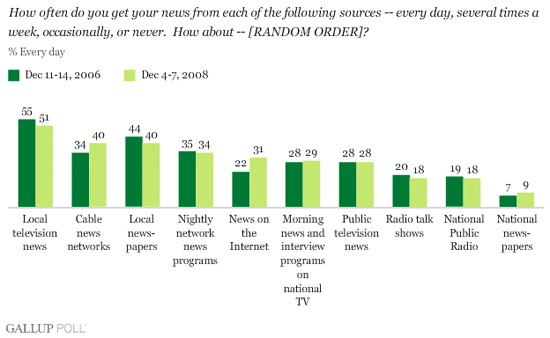
Local television news continues to be Americans' preferred source of daily news, with more than half of Americans (51%) saying they turn to it daily. Cable news and local newspapers are everyday sources of news for 40% of Americans. And for the first time since Gallup began asking this question in 1995, significantly more Americans say they turn to cable news networks daily than say they turn to nightly network news programs, though it is worth noting that the popularity of the network news programs has remained fairly stable compared with recent years.
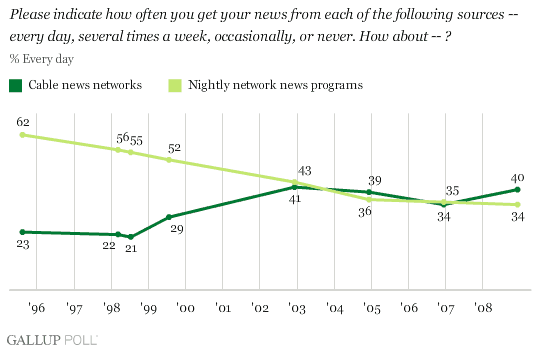
Not surprisingly, the Internet has shown the biggest increase in popularity as a news source, with 31% of Americans now saying it is a daily news source. This marks a nearly 50% increase since 2006 and a more than 100% increase from 2002. Use of the Internet as a news source has increased each time Gallup has asked about it, beginning in 1995.
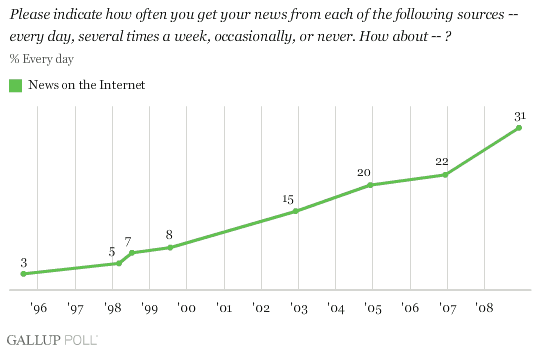
The bankruptcy filing last week by the Tribune Co. -- which publishes the Chicago Tribune, the Los Angeles Times, The Baltimore Sun and other daily newspapers -- is a sign of continuing distress for the nation's newspapers, which have in recent years struggled to stay afloat in the midst of declining readership and dwindling advertising dollars. Fewer Americans than at any time in a decade say they read a local newspaper daily, and fewer than 1 in 10 say they read a national newspaper like The New York Times, the Wall Street Journal, or USA Today each day. This year's slight uptick for the latter, from 7% to 9%, is within the survey's margin of error.

National Public Radio, which last week announced its first organization-wide layoffs in 25 years owing to a steep decline in underwriting, has actually maintained steady listenership over the years. The 18% of Americans this year who say they turn to National Public Radio daily is in fact exactly on par with the 18% who said the same in 1995.
Among weekly news sources, Sunday morning television news programs are up ever so slightly in popularity and now are at their highest point ever. On the flip side, evening television newsmagazine shows are declining in popularity, as are weekly newsmagazines.

The decline in popularity for weekly magazines like Newsweek, which announced layoffs last week, marks a steep dropoff from 2006 and an all-time Gallup low.
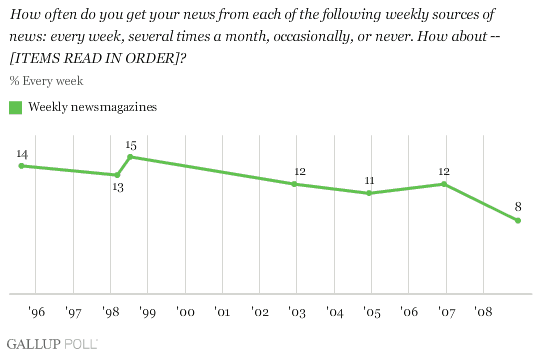
Because most news organizations rely on advertising as an important source of revenue, Americans in the critical 25 to 54 age demographic are the most sought after. This year's update reveals, for the most part, solid gains among young and middle-aged Americans for Internet news, cable news, and, interestingly, national newspapers. More generally, Americans 65 and older remain the most frequent consumers of all types of daily news.
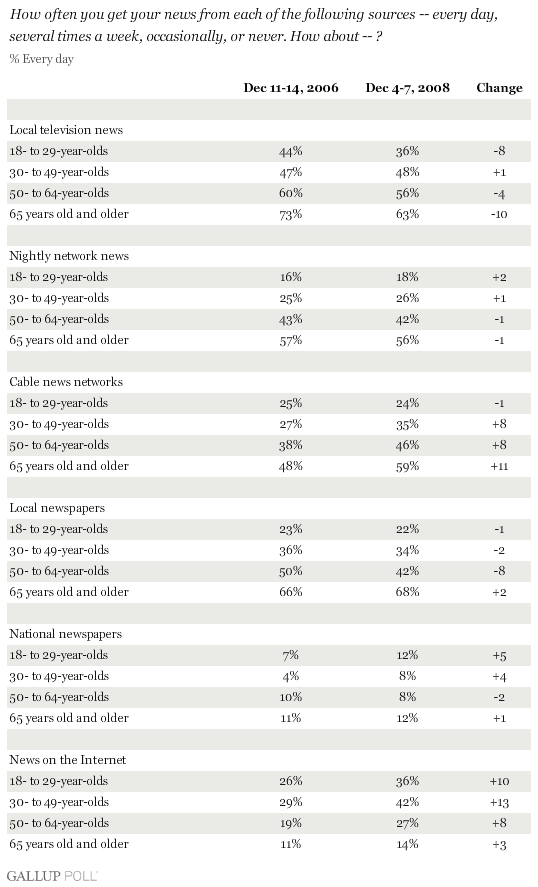
Bottom Line
In already-tough times for the news organizations, there are few signs that things will get easier anytime soon. Only cable and Internet news sources appear to be growing their audiences in any measurable way. At the same time, most media are holding steady or slipping only slightly, which may come as good news for some. Together, these data suggest the audience may still be there for most traditional news sources, underscoring the need for media organizations to find new ways to turn eyeballs into revenue. For many, this may require discovering creative ways to capitalize on the growing thirst for Internet news.
Here is the full table with results from this year.
Survey Methods
Results are based on telephone interviews with 1,009 national adults, aged 18 and older, conducted Dec 4-7, 2008. For results based on the total sample of national adults, one can say with 95% confidence that the maximum margin of sampling error is ±3 percentage points.
Interviews are conducted with respondents on land-line telephones (for respondents with a land-line telephone) and cellular phones (for respondents who are cell-phone only).
In addition to sampling error, question wording and practical difficulties in conducting surveys can introduce error or bias into the findings of public opinion polls.
